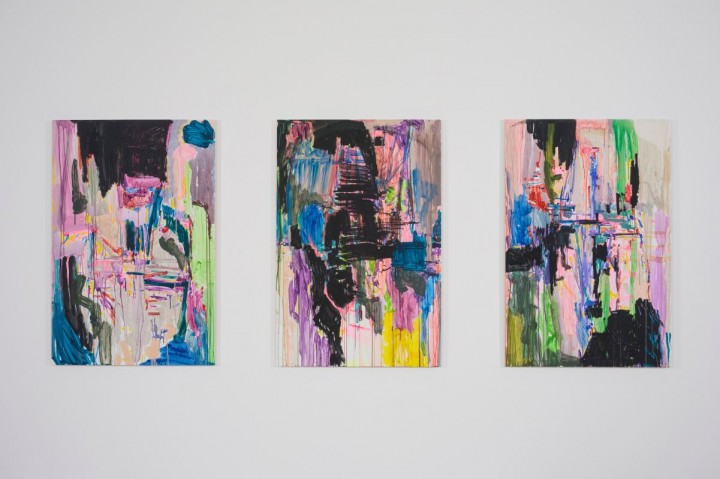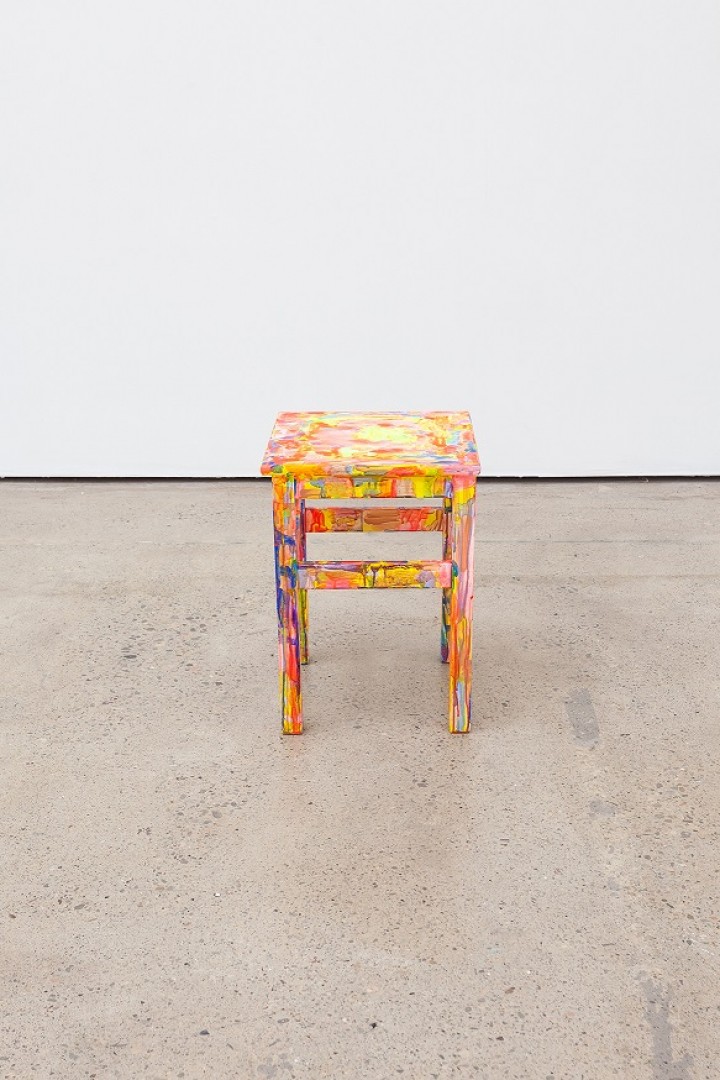Scottish Art News
Latest news
Magazine
News & Press
Publications
On Painting / Painting On
By Greg Thomas, 23.11.2022

You are allowed to sit on the chairs. It’s a feature of Hayley Tompkins’s current exhibition at Fruitmarket that seems important to mention, because otherwise the gallery’s pristine aesthetic might detract from the homely, anti-presentational aspects of the pieces on display (a selection of Tompkins’s painted household objects alongside films and abstract canvases.) Some of the chairs have been done up in messy stripes. On others, planes of colour cover particular sides or surfaces, as if they were extensions of shadow or atmospheric light. The key point, however, is not so much about what the chairs look like but what the informality of their placement across Fruitmarket’s downstairs gallery, and the invited mode of interaction, suggests about Tompkin’s attitude to her craft. Painting is not geared around the creation of slick, finished forms, but is a practice or a spirit to be folded into the everyday, a mode of being and seeing.
That’s not to say that painting in the conventional sense isn’t in evidence. Upstairs, a sequence of canvases created with thin, quivering brushstrokes, worked on in batches, imbibes the spirit of various modern schools. Patches of flat, bright colour in works like ‘Speak to Stripe’ (2022) almost suggest Cloisonnisme, while the downward trickles of paint in the ‘Spell’ sequence are more like action painting. The neon colour palette of these and other works would find a home amongst the luminous gesturalism of contemporary artists such as Jadé Fadojutimi, who are reviving painterly abstraction with a focus on its relevance to ordinary lived experience rather than grand spiritualism. The most successful component of the exhibition, meanwhile, is a raised bed of ravishingly bright, acid-yellow flooring ‘(But I don’t even think it's you [2022])’ in a ground-floor antechamber, topped with rigid paper bags and a box daubed in matt, worked-over layers of acrylic. We are not permitted to enter. Interestingly, the formality of this gesture, and the resultant sense of aura around the work, emphasises the beauty of the composition – the sharpness of colour contrast between form and ground, a delicious crispness of edge – in a way that doesn’t seem typical of the artist’s approach.
 Hayley Tompkins, LB, 2018, Acrylic paint on wood. Courtesy of the Artist and The Modern Institute/ Toby Webster Ltd., Glasgow. (c) the Artist. Photo Credit: Patrick Jameson.
Hayley Tompkins, LB, 2018, Acrylic paint on wood. Courtesy of the Artist and The Modern Institute/ Toby Webster Ltd., Glasgow. (c) the Artist. Photo Credit: Patrick Jameson.
If much of Tompkins’s work is concerned with pushing painting beyond its inherited boundaries, her films express an inverse animus, bringing the eye of a painter to the camera screen, and by implication to humdrum observations of the world around us. Soft-focus, intimistic shots stack up across five screens. In many cases what we see is filmed pages of text, image, or advert from magazines. There is a pervasive clicking sound, as if we were shuffling between slides on an old-fashioned carousel. ‘Interstice’ (2008) shows items on a mantelpiece in soft light, amongst other scenes (a touch of Old- Masters colour palette) while ‘Lent Moving Pictures’ presents images of clothing at two removes: as photographs on pages filmed whilst being moving around in front of the camera. Newer work ‘And Sunflowers’ (2022) is all cracked paving and tangles of wire, the shadows of grass and leaves on a white surface, snatches of a cat’s head. Here is film as painting or proto-painting: as the collation of objects and scenes encountered in day-to-day life (filmed on camera phones) framed, abstracted, and collaged to produce something like the raw cognitive materials of painterly creativity.
Elsewhere upstairs are bricolage-type arrangements including a bucket with photos and painted frames scattered up the wall above it, the sleeve of a school-shirt daubed in patches of purple, and two larger shirts stiffened with thick, scuzzy rainbows of acrylic. It’s fun, and there’s a point here about painting as an elevation of the ordinary which Tompkins makes with subtlety and dexterity. One wonders, however, if the mode of presentation might have been tweaked to bring a greater degree of domesticity, of the quotidian and informal, to the gallery space in order to better frame this message—somewhat as Norman Gilbert’s wonderful current show at Tramway involves the transformation of the front gallery into a summerhouse or living room. Still, much to enjoy.
Far by Hayley Tompkins is exhibited at the Fruitmarket until 29th January.




